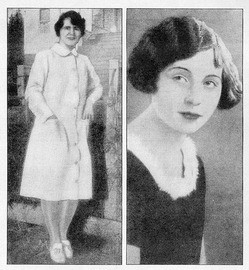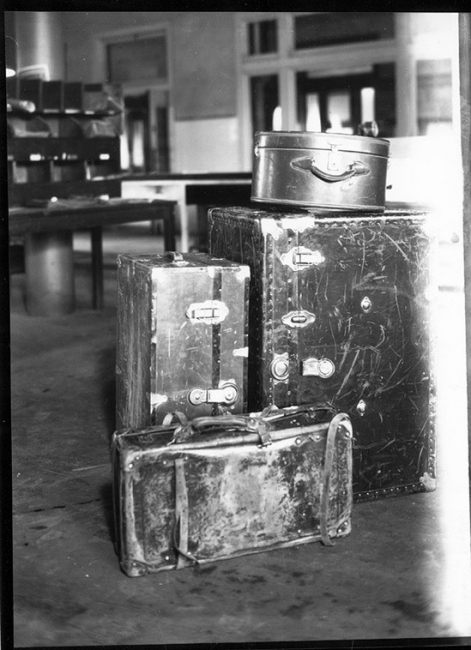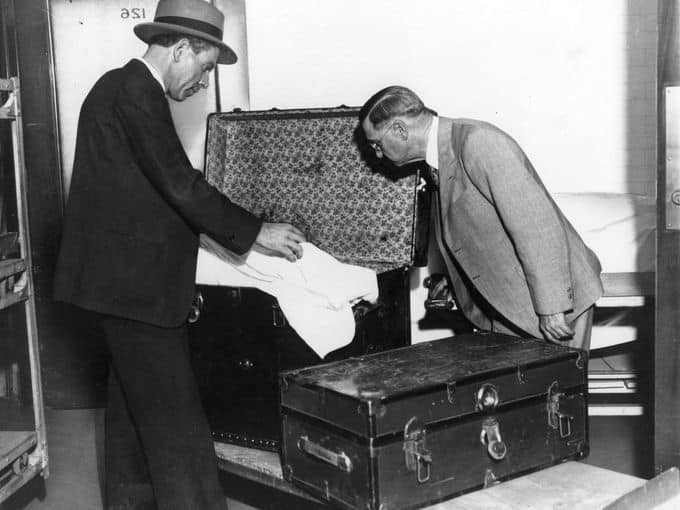In November of 2016 I had a chance to visit the former house of famed Phoenix, Arizona “murderess”, Winnie Ruth Judd. Some people call it the “death house” or “murder house”.
It’s a weird sight. Dwarfed by tall, gleaming corporate buildings and construction, the house looks out of time and out of place. A somber little purple-gray cottage with cracking walls, sitting on a bare, sandy lot enclosed by chain link fence, a person would be hard-pressed to walk by the property and not ask, “What happened here?”
Of course if you’re from Phoenix you probably already know. More so, you might even feel some cultural pride about the house’s history.
Standing obstinately in its lot for close to 100 years (and counting, thanks to a private owner with plans to preserve it), the house is something of an enduring homage to the woman who made it famous. Despite being touched by death, the community is not repelled by the house or the deadly circumstances surrounding it, instead they find it “unifying”.

“If it happens in Phoenix, they’re proud of it,” jokes filmmaker, author, and Winnie Ruth Judd historian, Scott Coblio. I recently had the opportunity to spend an afternoon chatting with Coblio, picking his brain about the more morbid details of Winnie’s case, as well as why he thinks people respond so strongly to her.
Coblio devoted much of his life to untangling the events leading to Winnie killing two women– Agnes “Anne” LeRoi and Sarah Hedvig “Sammy” Samuelson. He says Phoenicians see Winnie and the deaths as part of the fabric of Phoenix culture and history. Death touched Phoenix, and Phoenix embraced it.
“Winnie was appealing. People were struck by how resilient she was. You didn’t know if she was hiding this monstrous dark side, or if she was the victim or the villain,” says Coblio. “She was feisty when oppressed.”
There’s no avoiding the macabre details of the case, but make no mistake, this is not just one more tasteless stop not the “dark tourism” highway. Somehow Winnie, in her flawed, twisted vivacity (The Velvet Tigress! The Blonde Butcher!) is the Phoenix death icon that appeals to both people’s sense of horror and humanity.
But what actually did happen? It’s not entirely clear.
“We still don’t 100 percent know [what happened] because she made three different confessions that are all diametrically opposed to each other. Each under legal advisement and, I assume, all strategic,” says Coblio.
However, after poring over police reports, Winnie’s confessions, letters, newspaper coverage, and writings by other “Winnie Ruth Judd theorists”, Coblio has a reasonable idea as to what happened on the night of the murders, and beyond. Coblio says the timeline of events, as he understands it, closely follows “Winnie’s version” of the story.
Girls Night Gone Bad
On Friday Oct. 16, 1931, Winnie Ruth Judd was at the Grunow Medical Clinic where she worked as a secretary, when her friend, coworker, and former roommate Anne, invited her over to her house that night. Anne said another friend was coming over, and maybe they could all play cards.
Winnie declined at first, but Anne persisted. Anne LeRoi lived with Hedvig “Sammy” Samuelson in a cottage on the corner of 2nd Street and Catalina Drive in Phoenix. Winnie, Anne, and Sammy had formerly all lived together in the house, but due to differences between the three women (READ: A MAN) Winnie had moved out a week prior.
“At this point there’s a lot of tension and strain between these three women,” Coblio explains. “Winnie had been writing her husband [struggling with morphine addiction in Santa Monica, California] all week complaining about Anne. She felt like she was ‘going crazy’ and Anne was making her crazy.” So things were not warm and fuzzy between Winnie, Anne, and Sammy.
Winnie decided that she was going to see her boyfriend, Jack Halloran that night instead. Halloran was a central figure in Winnie’s case. A popular, wealthy businessman in Phoenix, everybody knew who Jack Holloran was, and everybody liked him. Jack especially liked the ladies.
Jack was tangled up in Anne, Sammy, and Winnie’s lives. The women were deeply dependent on him, financially and emotionally. “He was their meal ticket,” says Coblio. More than that, they each felt rather possessive of Jack’s attention. But it seems that Winnie was the one with whom which Jack had the closest relationship. At least, as far as Winnie knew.
Winnie called Jack after work that night and he said that he’d come over to her apartment around eight or nine o’clock. Nine o’clock came and went, and no Jack. Winnie was pissed.
“So around 10 o’clock she left her apartment and went to Anne and Sammy’s house. They told Winnie, ‘Why don’t you stay the night with us?’”
Winnie agreed to stay, and the gals sat around in the back bedroom gabbing over cups of rice pudding (allegedly – it’s not entirely clear what the pre-murder snack of choice was). At one point in the night Anne asked Winnie, “How did it ever come about that Jack met Lucille Moore?” Anne and Sammy had recently seen Jack, Winnie, and Lucille spending time together, and they were none too pleased. It was believed that Lucille was being treated for syphilis. Scandal!
So the women began arguing about Jack, Lucille, and the syphilis. Winnie argued that professionally she couldn’t divulge Lucille’s medical history to Jack, and besides Lucille and Jack were just friends.
Anne and Sammycalled BS on this, and Anne threatened to tell Jack about Lucille’s SYPHILIS.

Not to be bullied, Winnie countered that if they divulged the SYPHILIS, then she’d tell everyone that the rumors of Anne and Sammy’s LESBIANISM were true! More scandal!
With those words, Winnie got up and took her cup of (alleged) rice pudding back to the kitchen down the hallway. There was (and still is) a breakfast room “which had a separate doorway that you can enter through from the living room”. Keep this layout in mind.
“According to Winnie, Sammy came running into the breakfast room with a gun and said, ‘If you tell anything about Anne at the clinic, I’ll shoot you sure!’”
The gun in question was Winnie’s. “It was supposedly left behind from when Winnie lived there with them. She had only moved out a week ago, so it is possible that she left the gun behind. If Winnie went to [Anne and Sammy’s] house with a gun, that casts more light of suspicion on her. Even I’m not sure,” says Coblio.
Regardless, Winnie and Sammy start wrestling for the gun. As they wrestled, Anne came running out of the bedroom with an ironing board that she proceeded to beat Winnie with. As Anne beat Winnie with the ironing board, she shouted, “Shoot her Sammy! Shoot!”
Picture this just for a moment: Winnie, Sammy, and Anne are in their pajamas. Sammy and Winnie are wrestling for a gun, while a screaming Anne beats Winnie over the head with an ironing board (the ironing board beating was supported by evidence, as “when [Winnie] turned herself in a week later, she had in excess of 100 bruises on her body”).
What do you do at your slumber parties?
In the struggle for the gun, Winnie got shot in the hand – but Sammy got shot in the chest. Finding herself in possession of the gun, Winnie turned and shot Anne. Remember this is Winnie’s telling of the events.
Winnie quickly got dressed and ran out of the house, back to her apartment, with the intention of calling her husband for help. But before she could do that, good ol’ “Happy” Jack Halloran showed up drunk. Winnie frantically told Jack what happened but he was like, “No way!” And Winnie was like, “Way!” (official case transcript…in my head) and dragged him back to the death house.
You know what they say about returning to the scene of the crime.
Have Corpse, Will Travel
“Back at the house, the girls were still lying on the floor. The first thing Jack did was turn off the lights, close the curtains, check their pulses, and pick up Sammy and put her on a bed. Sammy’s the only one he seemed concerned about.”
As Winnie cleaned up the house Jack told her, “For God sake, don’t call your husband! Don’t call the police! Do you know what this means to you and me if you tell anyone about his? Leave everything to me.”
He then told Winnie to get the steamer trunk from the garage. “We’ll put the bodies in that, and I”ll bring them out to the desert.”
Jack told her to go to work the next day and act like she didn’t just kill her former roommates, and wait for a call from Jack. Winnie did as she was told, rattled, frightened, and still with a bullet in her bandaged hand.
Finally Jack called, telling her “I was unable to take care of those parties as planned. You’re going to have to take them on the train to L.A. I’ll have a man named Mr. Wilson waiting to meet you and together he’ll drive you to the beach,” where the bodies would be disposed of. While this exchange cannot be 100% proven, if it did transpire as Winnie claims it did, Halloran may very well have been setting Winnie up. “Jack Halloran has to know this is a terrible plan,” says Coblio.
After work Winnie went back to Anne and Sammy’s house to take care of the bodies. The delivery man was met with a strange sight. “She’s standing in the dark [in the house], next to this trunk, and she says, ‘I’m sorry, but I have to transact our business by the list of candles. The electricity has been turned off as we are moving.’” Winnie really tried to play it cool, she really did.

But then – you guessed it – she flipped on a light switch.
Illumination faux pas aside, the delivery man told Winnie that the trunk she wanted him to deliver to the train station (the trunk containing the bodies of Anne and Sammy) was over the weight limit and she’d have to pay extra. Lacking the funds, she told the delivery service to take the trunk to her apartment. With Jack not returning her calls, Winnie had to take matters into her own hands.
“So it’s Saturday night, she’s alone with this trunk, and she has the mastermind plan to separate the contents of the single trunk into a number of pieces of luggage so no one piece will be over the weight limit.”
Either the women were immediately shoved in the trunk or, as a Dr. Wagner stated during Winnie’s trial, Sammy was immediately dismembered – at least one to nine hours after death – and put in the trunk. Winnie and Jack may have waited too long and rigor mortis had set in, forcing them to dismember Sammy at the house.
There’s also some question as how pliable (if she was intact) Sammy was once Winnie decided to chop her up. Winnie was small woman who had been plagued with tuberculosis throughout her life. Could she really have moved and chopped a rigid corpse all by herself? Let alone efficiently?
The scenario that is largely agreed upon is that if Anne and Sammy were killed around 6am on Saturday morning, the corpses could have speedily been put in the trunk before full rigor set in, and by the time Winnie starting splitting Sammy between her luggage, in the early hours of Sunday morning, rigor would have broken and she would have been soft enough for Winnie to manipulate and move “inch by inch” as she said.
Winnie distributed Sammy’s corpse between several smaller pieces of luggage: a smaller trunk, a suitcase, and a hat box.
According to Coblio, Anne got to stay in the big trunk and the bulk of Sammy’s body was split between the smaller trunk and the suitcase. Additionally, Winnie filled her luggage with “personal letters”, evidence that could convict her, because she was so confident that everything would be disposed of in Los Angeles.
Winnie took the train to Los Angeles, a day later than planned. There was no mysterious Mr. Wilson upon her arrival, but she’d arranged for her brother to pick her up.
However, there was a problem with her luggage. Imagine that. It seemed the trunks were leaking a foul smelling liquid, along with something that appeared to be blood. PRO TIP: chopped up, three day old bodies are going to ooze more than the allotted fluids you’re allowed to travel with – plan accordingly!
When the officials at the train station asked her for the key to open her luggage in order to examine it, she simply said she didn’t have the key and walked out.
Winnie briefly spoke with her brother before disappearing into Los Angeles for a week. Coblio says she seemed to have a “cloak of invisibility”. Walking all over Los Angeles, and all the way to Pasadena, Winnie laid low and took refuge where she could. And this was all with a hand slowly turning gangrenous from the bullet still lodged in it. You can’t say that Winnie wasn’t scrappy.
One of her hideouts was La Vina Sanatarium in Altadena where she had been a tuberculosis patient years earlier. “She found a vacant cottage there and slept for two days.” (Scrappy.)
But Winnie’s story was the talk of the Los Angeles area. Winnie heard people talking about her, talking about her husband, and speculating about her whereabouts. At one point she heard someone reading a newspaper article aloud (perhaps for her benefit?) about how her husband wanted her to turn herself in and HERE’S THE NUMBER TO CALL, WINNIE.
“So she called [the number] and her husband sent a guy to pick her up. They brought her to a funeral home, the Alvarez & Moore Funeral Chapel” where Winnie was reunited with her husband, William C. Judd, before turning herself into the police.
Winnie was mobbed by photographers on the steps of the funeral home wearing a fur coat she’d stolen from La Vena Sanatarium. She was “ultra glamorous, beautiful…very cinematic,” said Coblio.
America began a twisted love affair with Winnie Ruth Judd, the Trunk Murderess.
The Trial
Winnie’s trial began on January 19, 1932 at the Maricopa Courthouse in Phoenix. Initially she was “being tried for only the murder of one of the girls, Anne. [Her defense] thought [Sammy’s] ‘dismemberment issue’ would be too incriminating. If she was found innocent for the death of Anne, they were going to try her again for the death of Sammy.”
Interestingly enough, every member of the jury was asked if they knew Jack Halloran, but it was never clarified why exactly they were asked this. Halloran was also present at the trial everyday, but never spoke on the record, and was never called as a witness.
Amidst all the hubbub, William Randolph Hearst – yes, that William Randolph Hearst – got involved and put “$20,000 in a defense fund for her. So she fires her lawyer and gets a hot shot lawyer who won’t let her speak, and they have this very unconvincing insanity trial.” (It’s speculated that Hearst and Winnie had an agreement: her “exclusive” life story – which she did write for him – in exchange for the money. Plus of course, Winnie’s trial was selling loads of papers for him.)
The prosecution went after Winnie on premeditated murder charges, saying her self-defense wounds were self inflicted. Winnie’s trial was a circus. Evidence was not always reliable, her confession was questionable, and the press ran rampant. The press was there taking notes when Winnie had surgery to take the bullet out of her gangrenous hand, she started speaking in her gas-induced stupor, saying things like, “I had to fight them…you’d have fought too…I fought so hard.”
On February 8, 1932 Winnie was found guilty and sentenced to die by hanging on February 17, 1933, Good Friday. But finally Winnie had had it. She told her lawyers she wanted to talk, that Jack Halloran had told her to exonerate him. He said that if she agreed, she wouldn’t be sent to prison or, you know, EXECUTED.
Jack Halloran was indicted for a preliminary hearing to determine if he should be tried as an accomplice to murder. At the hearing Winnie spoke at length, famously stating, “I am going to be hanged for something Jack Halloran is responsible for…I was convicted of murder, but I shot in self-defense. Jack Halloran removed every bit of evidence. He is responsible for me going through all this. He is guilty of anything I am guilty of.”
The judge and jury agreed that it was not homicide, but self-defense. Happy Jack got to walk free, but Winnie did not, despite this trial’s ruling in her favor. Her death sentence did not change. However, “In the 11th hour the, sheriff of the jail where she was being held, found a really antiquated loophole wherein if he personally thinks she’s insane, he can request an insanity hearing for her. So he uses the loophole.”
Winnie writes yet another confession, this one ranting and raving, possibly coached for the purpose of receiving the insanity trial. In it, she tells a drastically different story of going to the house with the gun, how her dependency on the drug Luminal was making her “crazy”, and that she acted alone. She got the insanity hearing, however the verdict had to be handed down in her favor before the day of her execution, otherwise she’d still hang.
HORRIBLE ARIZONA HANGING FACT: The only woman to be executed by hanging was Eva Dugan in 1930. Something went wrong, and her head came off. You heard me.
With only hours to spare, Winnie Ruth Judd was declared insane and sent to Arizona State Hospital where she could stay “with the stipulation that if she was ever to be rehabilitated and found sane, she must immediately be hanged.”
Life After Deaths
Winnie lived at the hospital for 40 years, escaping at least six times. You see, the nurses were so fond of Winnie that they gave her a key to the front door of the hospital. They never even changed the locks after her escapes. Winnie was very popular, and even became a sought-after hair stylist. “She started doing finger waves for the women in the hospital to make them feel better about themselves. Soon it became fashionable for society people to go have their hair done by Winnie at the state hospital.”
The longest of her escapes lasted six years. Yes, that’s correct six human years. During her six-year absence from the hospital, Winnie became the nurse to a wealthy woman in California who came to really love her, and willed to her a huge some of money as well as “a house on her property” upon her death. Unfortunately Winnie’s nephew, who was blackmailing her “threatening to turn her in if she didn’t give him her paycheck”, did just that and the police arrived at the rich lady’s house to take Winnie away. So back she went to the state hospital.
But luck was on Winnie’s side. Lawyers Larry DeBus of Phoenix and Melvin Belli of California worked together to get Winnie paroled in 1971. After over 40 years living “under the shadow of the noose”, Winnie was free.
***
And that, Deathlings, is the long, twisted tale of Winnie Ruth Judd. Was she guilty? Was she innocent? Was she something in-between? Was her entire life simply a struggle to survive? The world may never know, Winnie made sure of that.
However, Winnie ignited something in the Phoenix community. The idea that death can be a part of a culture but not necessarily darken it. One could argue that folks are looking at the murders through rose-colored glasses, but I find it remarkable that there isn’t an obscene or exploitative feel to the speculation.
In fact, talking with Scott Coblio about Winnie was oddly uplifting; we found ourselves tossing around words like “spunky”, “survivor”, and “complex heroine”.
Yes there is a morbid fascination with Anne, Sammy, Jack, and Winnie, but it seems to be genuine wonder and curiosity about what really happened. Death is part of the cultural conversation. You can’t look at the case of Winnie Ruth Judd, look at the deaths of Anne and Sammy, without looking at death; without considering what happened to their corpses, what the reality of that was. But Phoenix does not seem fazed by it. In the preservation of Winnie’s story, the house, Halloran’s house, and the ongoing interest in the case, Phoenix seems at peace, even proud, with how death exists in their history.
Louise Hung is an American writer living in Japan. You may remember her from xoJane’s Creepy Corner, Global Comment, or from one of her many articles on death, folklore, or cats floating around the Internet. Follow her on Twitter.
Thank you to Scott Coblio for talking with me about Winnie Ruth Judd. Interested in reading more of Scott’s thoughts and theories on the case? Keep an eye out for his upcoming book. Scott also made a delightfully bizarre documentary-puppet noir film (yes, PUPPETS) about Winnie called “Murderess: The Winnie Ruth Judd Story” which screens every year in Phoenix. Get updates on Scott, his film, and his projects on the Murderess Facebook page.
Resources
Phoenix New Times articles:
“Ruthless: A Long-Lost Confession Letter May Finally Tell the Real Story of Winnie Ruth Judd”
“Baggage Claim: One Writes About Murderess Winnie Ruth Judd at One’s Own Expense”
“The Winnie Ruth Judd ‘Murder House’ Cheats Death in Central Phoenix”




